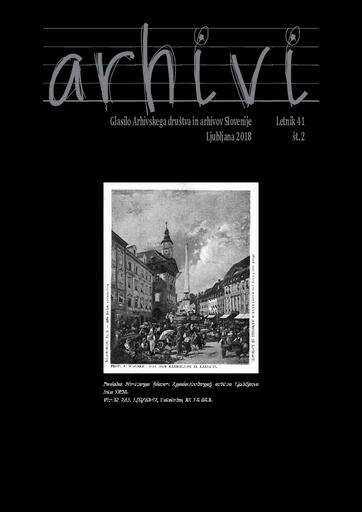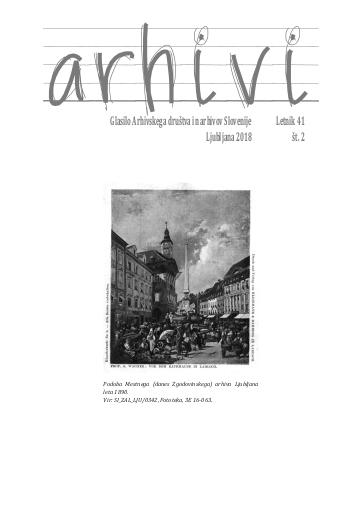/
Serijske publikacije
/
Arhivi
Imenjska knjiga za Kranjsko. Plemiška rodbina Semenič v imenjski knjigi


To delo avtorja Lidija Slana je ponujeno pod Creative Commons Priznanje avtorstva-Nekomercialno-Deljenje pod enakimi pogoji 4.0 Mednarodna
Datoteke (1)

Opis
V Arhivu Republike Slovenije se nahaja zanimiv fond z nazivom SI AS 173 Imenjska knjiga za Kranjsko (1539–1871). Fond vsebuje 25 knjig, v katerih so vpisani v denarju izraženi dohodki – imenjske rente lastnikov imenj na Kranjskem, sprva le od denarnih in naturalnih dajatev podložnikov, po davčni rektifikaciji v letu 1747 pa tudi od pristav oziroma dominikalnih imenj. Podatki iz imenjskih knjig so imeli izključno davčni namen. Zaradi vpisov lastnikov imenj je bila po davčni rektifikaciji imenjska knjiga tudi dobrodošla podlaga za pripravo deželne deske, z uveljavitvijo zemljiške knjige pa je izgubila svoj pomen in je bila leta 1871 ukinjena. V drugem delu prispevka so na konkretnih primerih zapisov v imenjskih knjigah predstavljeni nekateri člani plemiške rodbine Semeničev, ki se je v Beli krajini pojavila v 14. stoletju, se konec 16. stoletja naselila tudi na Dolenjskem in izumrla v drugi polovici 18. stoletja.
Metapodatki (12)
- identifikatorhttps://hdl.handle.net/11686/41625
- naslov
- Imenjska knjiga za Kranjsko. Plemiška rodbina Semenič v imenjski knjigi
- The Property Book for Carniola. Noble Family Semenič in the Property Book
- ustvarjalec
- Lidija Slana
- soavtor
- Gregor Jenuš (gl. in odg. ur.)
- Dunja Mušič (teh. ur.)
- Petra Markuš (prev.)
- Dunja Mušič, Vanja Pfajfar (foto.)
- predmet
- IZ ARHIVSKIH FONDOV IN ZBIRK
- imenje
- imenjska renta
- imenjski davek
- imenjska knjiga za Kranjsko
- davčna rektifikacija
- deželna deska
- zemljiška knjiga
- plemiška rodbina Semenič
- Bela krajina
- Dolenjska
- FROM THE ARCHIVAL FILES AND COLLECTIONS
- property
- property income
- property tax
- property book for Carniola
- tax rectification
- land board
- land register
- noble family Semenič
- Bela krajina (White Carniola)
- Lower Carniola
- opis
- In the Archives of the Republic of Slovenia a fond named »Imenjska knjiga za Kranjsko« (Property book for Carniola (SI AS 173 1539-1871) which contains almost complete collection of property books with entries of the properties of the estates of the realm and the properties of free tenants in the former Duchy of Carniola and later a crownland can be found. The value of the property was expressed with the property income or feudal estate income expressed in monetary form, especially income relating to payments in money and contributions in kind. As early as the 15th century, the main purpose of the evaluation of property of provincials was determining contributions for military defence of the country, and later on also an obligation to pay an extraordinary provincial tax endorsed by provincial assembly for general defence of the province and the administrative and personal needs of provincial prince. Until Maria Theresa introduced reforms, only the tributes of serfs were included in the basis of taxation because nobles were on the basis of verified privileges from the 14th century exempt from taxes due to military service. With the implementation of mercenary military and rising absolutist might of monarch, this privilege of nobility moved into the background and thus they too had to pay taxes from the income of manor house with its infrastructure from the middle of the 18th century. This change is evident in the composition of property books pre- and post-tax rectification (1748-1758). Prior to tax rectification, there were seven property books where taxable persons were arranged under the provincial estates hierarchy. Prelates are atthe top, followed by the lower clergy, brotherhoods and hospitals, nobility, towns, squares, and free tenants. A property owner was responsible for entering property income, consequently numerous irregularities occurred or entries were even suspended. The discipline of entering properties increased with the establishment of property books after tax rectification, in particular due to greater control, implementation of special cadastre, and particularly due to the land board. Dominical and rustic land were shown separately and were also taxed separately. After tax rectification, there were twenty property books left, eighteen were preserved and allocated to three counties in Carniola. The property book was still useful in the 18th and 19th centuries while transferring data on properties to the land board, but lost all meaning and was abolished upon the implementation of the land register in 1871. Semenič noble family who lived in White Carniola (Bela krajina) since the 14th century, in Lower Carniola from the 16th century, and died out in the 18th century, appeared in the first six property books, and in another one after tax rectification. Modern history views researching property owners and their property incomes as valuable in particular due to an overview of their material standing and numerous genealogical data which may help in researching certain noble family or family of free tenants by simultaneously using other sources.
- založnik
- Arhivsko društvo Slovenije
- datum
- 2018
- tip
- besedilo
- jezik
- Slovenščina
- jeDelOd
- pravice
- licenca: ccByNcSa
